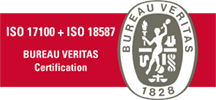Communicating without borders: the crucial role of translation companies
Translating is not just a matter of replacing one word with another. Translating is an art that involves much more than just the knowledge of two languages.
The need for a translation company is often underestimated by companies looking to expand their global presence and reach a wider audience. Translation is a complex process that, when done correctly, can open doors to new markets and business opportunities.
Wrong translation can be costly
A common example of mistranslation is the difference between the words “attention”, “warning” and “danger” on a product label. Although they may seem synonymous, these words have different legal implications and, if translated incorrectly, can mean serious legal problems for your company.
Incorrect translations have the potential to weaken or even distort the essence of your message. This deviation can not only compromise your company’s image, but can also mean significant financial costs.
It’s time to call in the professionals
Translation, at first glance, may seem simple for those who are fluent in several languages. However, the reality is that if it were that simple, then there would be no difference between a translation done by a machine and a translation carried out by a human being.
In reality, translation is much more than just replacing one word with another. It requires a deep understanding of the language, including its details, nuances and subjective and contextual meanings. In addition, the translator must be immersed in the culture of the target language in order to be able to effectively translate your brand and your message.
For all these reasons, it is essential to hire a translation company that uses only native translators who are experts in their areas of expertise. Only these professionals will be able to translate your content accurately and effectively, ensuring that your message is conveyed in the right way.
Translation process
The translation process involves several steps, which vary depending on the type of content to be translated.
A simple example of the translation process:
- Definition of needs: The client presents the content to be translated, which can vary in terms of formats and content to be translated, from text documents to websites, through files in Adobe InDesign or Illustrator, to training videos and PowerPoint presentations. A Project Manager is assigned to each project, taking responsibility for guiding the client from planning to final delivery, ensuring a clear understanding of the client’s expectations, requirements and deadlines.
- Project management: The project manager defines most suitable translator’s profile, or team of translators, for the translation project. The PM is also responsible for carrying out periodic quality checks during the project lifecycle, ensuring that it is delivered according to the client’s specifications and within the agreed deadline.
- Glossary creation process: A specific glossary is compiled for the translation project, reviewed by the translation team, and, after the client’s approval, used to ensure consistency during translation.
- Translation process: A qualified translator, or a team of translators (for more complex projects), perform(s) the translation in the project. These translators are native speakers of the target language and specialised in the topic or area of translation.
- Review process: After translation, an initial review is carried out by the translation team, followed by a final review by an experienced reviewer, ensuring the accuracy and quality of the translated text.
- Quality assurance: A final quality check of the translation is performed, ensuring that the project fully meets the client’s expectations and requirements. This control also takes place during the translation project implementation phase, making it possible to ensure the timely correction of any errors found. Other parameters are also checked, such as whether the client’s instructions have been followed or whether the client-approved glossary has been used.
- Finalisation and delivery: The Project Manager makes the last technical verifications, updates glossaries and translation memories and proceeds to deliver the finished project to the client.
- Satisfaction assessment: A few days after the delivery of the project, a satisfaction questionnaire is sent to assess the client’s satisfaction with the work completed.
Translation is more than just replacing words
Translation is much more than just replacing words; it requires in-depth knowledge of both the source and target languages, as well as the local culture, in order to ensure that your message is conveyed appropriately to your target audience.
It is vitally important to rely on the services of an experienced translation company, such as M21Global. With our vast experience and team of native translators specialised in technical, legal and commercial translation, we guarantee the quality and accuracy of your translations.
Our meticulous approach to the translation process, from defining each client’s specific needs to finalising and delivering the project, ensures that each translation not only meets, but exceeds our client’s expectations.
Choosing M21Global means choosing a translation company dedicated to excellence in translation. We are committed to delivering high-quality translations that reflect the true essence of your message, helping your company communicate effectively with your target audience in any language and culture.
We invite you to contact us today to discuss how we can help you achieve your global communication goals with translation services you can trust. Together, we can ensure that your message is understood around the world, while maintaining its intended integrity and impact.

